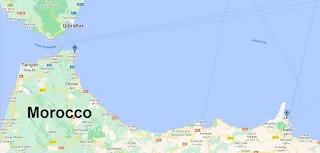Spanish Claimed Land Inside Morocco
In 2023, learn the historical and legal agreements and principles that solidified the status of Ceuta and Melilla as Spanish territories within the African land of Morocco. Both Ceuta and Melilla are enclaves, which are pieces of land completely surrounded by the territory of another country. Ceuta and Melilla are approximately 250 miles or 400 kilometers apart from each other.
Ceuta and Melilla are geographically separated from the Spanish mainland and surrounded entirely by Moroccan territory.
Imagine if there were two small U.S. territories, let's call them Thisismine and Iclaimthis, located within the borders of Mexico. These territories have no direct land connection to the United States and are entirely surrounded by Mexican territory. Like Ceuta and Melilla in Spain, Thisismine and Iclaimthis would be enclaves within another country, with special geographical and political considerations.
Both Ceuta and Melilla are enclaves, which are pieces of land completely surrounded by the territory of another country. Situated on the African continent within Morocco, off the Mediterranean coast of North Africa, and across from the southern coast of Spain, Ceuta and Melilla hold a crucial strategic position in the Mediterranean and the Strait of Gibraltar. The distance from Ceuta to Spain is 14 miles or 23.4 kilometers across the Strait of Gibraltar, and the distance from Melilla to Spain across the Mediterranean Sea is roughly 130 miles or 209 kilometers.
Ceuta and Melilla, as Spanish enclaves, have erected border fences to control the migration of people and goods between these territories and the surrounding Moroccan territory. The fences serve as a barrier to prevent unauthorized migration into the Spanish enclaves. These fences also play a crucial role in demarcating the Spanish enclave and Moroccan territory's border. They define the limits of the autonomous cities of Ceuta and the larger city, Melilla.
The geographical location of Ceuta and Melilla on the African continent and their status as European territories have made them focal points for migrants seeking access to the European Union. Despite efforts by Moroccan and Spanish security forces to forcibly expel these undocumented migrants and address Europe's security concerns, such measures have proven ineffective. The construction of border fences has also not succeeded in lessening the gravity of the situation.
 |
| Morocco, Ceuta and Melilla |
Ceuta and Melilla, Spain's continued colonial presence in Morocco.
Before the year 1415, at the turn of the 15th century, Ceuta was a strategic and prosperous city located on the northern coast of Morocco. It was under the rule of the Marinid dynasty, which was centered in Morocco. Ceuta had long been a prominent trade center in the Mediterranean, and European powers highly sought its control.
The Portuguese forces besieged Ceuta, with the siege beginning in May 1415. The siege lasted for several weeks, during which the Portuguese launched assaults on the city's defenses, including its fortifications and walls.
The military conquest of Ceuta was led by Portuguese forces, particularly King John I of Portugal and his sons, including Prince Henry the Navigator. The Portuguese had been actively involved in overseas exploration and maritime trade, and they viewed Ceuta as a valuable prize due to its strategic location and economic potential.
The defenders of Ceuta, known as the Marinids and led by Abu Sa'id Uthman III, put up a strong fight against the Portuguese siege. Abu Sa'id Uthman III was the Sultan of Morocco under the Marinid dynasty, which was a Berber Muslim dynasty that ruled parts of North Africa, including what is now Morocco.
Despite the fierce resistance, the fortifications of Ceuta eventually succumbed to the Portuguese siege tactics, which included the use of cannons. This resulted in the destruction of the once prosperous North African city and marked the end of the Marinid dynasty's rule.
On August 21, 1415, the Portuguese successfully breached Ceuta's defenses and captured the city. The capture of Ceuta was a significant achievement for Portugal, allowing them to establish a strategic base on the North African coast. The city was a valuable trading post and provided access to trade routes in the Mediterranean and across the Strait of Gibraltar.
Portugal held control of Ceuta for over a century. Ceuta's capture was a precursor to further European expansion into North Africa and marked the beginning of the Age of Exploration.
In 1494, the Treaty of Tordesillas was signed between Spain and Portugal. This treaty divided newly discovered lands outside of Europe between the two countries. The Treaty of Tordesillas primarily focused on addressing the overseas territories that European powers explored during the Age of Exploration. It was signed in the Spanish town of Tordesillas and aimed to resolve conflicts and disputes over the newly discovered lands.
The treaty drew an imaginary line from north to south, running through the Atlantic Ocean and the newly discovered lands. This line, known as the Tordesillas Line, was located a certain distance west of the Cape Verde Islands. The treaty established that everything to the east of this line fell under the influence and control of Portugal, while everything to the west was under the influence and control of Spain.
Spain and the Treaty of Tordesillas, Treaty of Lisbon and the principle of Uti Possidetis claim over Ceuta and Melilla.
Treaties and principles that established a legal framework for Spain to claim, explore, and colonize their respective territories of Ceuta and Melilla were the Treaty of Tordesillas, the Treaty of Lisbon, and the principle of Uti Possidetis.
The legal authority for Spain's claim to Ceuta and Melilla derives from a combination of historical acquisition through conquest and international agreements such as the Treaty of Tordesillas. These agreements and the principle of Uti Possidetis, which upholds the continuity of colonial borders, have supported Spain's authority over these enclaves.
Uti Possidetis supports the idea that colonial borders should continue to be recognized when new states emerge. Uti Possidetis says that when countries become independent, they should keep those borders the way they were when they gained independence.
Thus, because of treaties and Uti Possidetis, even though Ceuta and Melilla are geographically separated from the Spanish mainland and surrounded entirely by Moroccan territory since Morroco was not under Spain's rule during decolonization, but Ceuta and Melilla were, therefore, they belong to Spain.
Spain obtained Ceuta from Portugal in 1668 as part of a territorial exchange. This agreement was formalized in the Treaty of Lisbon. In the Treaty of Lisbon, Portugal ceded Ceuta to Spain, and in return, Spain ceded seven towns in the region of Brazil to Portugal.
Spain obtained Melilla in 1497 when Pedro de Estopiñán, a Spanish conquistador, captured it. This marked the beginning of Spanish control over Melilla, and it has remained under Spanish sovereignty since that time.
 |
| Spanish conquistador |
Morocco has sought to reclaim Ceuta and Melilla from Spain
Morocco has sought to reclaim Ceuta and Melilla from Spain, viewing these enclaves as integral parts of its territory. Morocco's claims are rooted in its literal geographic bond, historical ties to the region and that these territories were colonized during a period of European colonial expansion.
The issue has led to diplomatic tensions and disputes between the two countries, with Morocco asserting its authority over these enclaves. Over the years, Morocco has taken various diplomatic and political measures to assert its claims and address the status of these territories.
Still, the issue remains unresolved, and Ceuta and Melilla continue to be under Spanish sovereignty. The enclaves' historical and political intricacies have made it a sensitive and longstanding subject in the relationship between Spain and Morocco.
Did you know?
Ceuta and Melilla are the only piece of European territory on mainland Africa; however, Lampedusa and Lampione islands are closer to the African coast than to Italy and are considered part of Italy's territory.


























